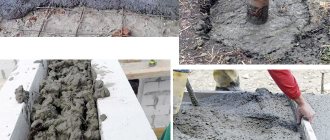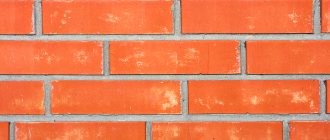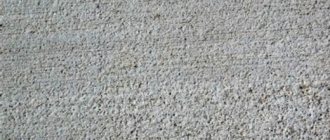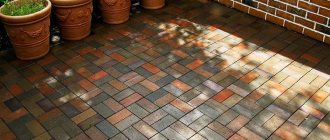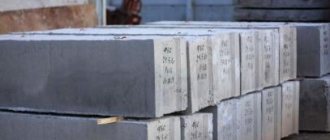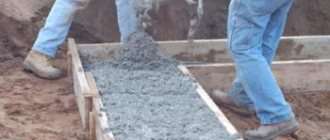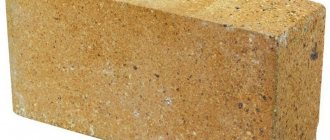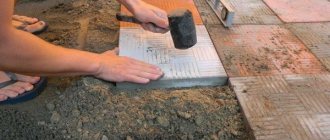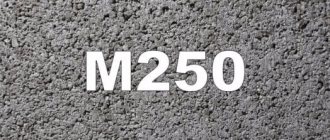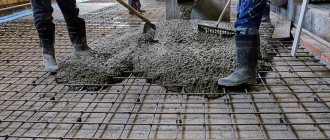Types of bricks in construction
Brick is an artificial product; it has a geometrically regular shape, and the quality of the shape is so high that a brick house does not require additional external finishing. It is made from a natural material that has the properties of stone, therefore, the brick is very durable, has excellent water resistance, and, as a result, frost resistance. Brick does not have pores into which moisture can pass and freeze. In addition, it is very heat-intensive, that is, it is able to accumulate heat that is generated by heating devices inside the building in winter. It is thanks to this quality that brick houses do not require external insulation.
There are three main types of bricks:
- Red brick, or ceramic, is made from clay and, after molding, fired in a kiln.
- White brick, or silicate, consists of quartz sand and lime with the addition of water.
- Hyper-pressed brick, also called cement brick.
Is it possible to add broken bricks to the foundation?
Material such as brick has long been used not only for the construction of various buildings, but also as a foundation. This option has become widespread in the construction of private houses with a height of no more than 3 floors.
In addition, when pouring a brick foundation, the following points should be taken into account:
- The soil must be hard, dry, not heaving or friable.
- The groundwater level should be low.
But, even if the soil is slightly mobile, a brick foundation can be laid, but you will first need to pour a reinforced concrete base.
If the groundwater is high, then in this case additional special components are used that are added to the solution to prevent the destruction of the material from moisture.
Only when deciding to use brick for the foundation, it is worth considering that its service life compared to the concrete option is much shorter.
In this case, you may be interested in the question: “Is it possible to add broken bricks to concrete?” This is what will be discussed in this material.
What is a boot and how to use it
Rubble, or, in other words, broken brick, appears as a result of the demolition of various brick structures, for example, houses, outbuildings and other objects. Also, secondary brick raw materials are obtained during the production of bricks directly at factories.
It is inevitable that you will receive broken bricks in the process of laying brickwork.
The use of recycled brick raw materials is very diverse.
It is used:
- To strengthen the soil on steep slopes.
- As a base for road surfaces during the construction of local roads, especially in marshy areas.
- Fireclay brick scrap is used as a filler when mixing refractory mixtures and may have other uses.
Is it possible to add brick to the foundation?
The rubble can also be used when pouring the foundation. But only when constructing small, one-story buildings. However, this option is not advisable to use if you plan to build a house.
Even if you decide to replace part of the crushed stone with broken bricks, when making a concrete mixture, you should understand that such a foundation will be less strong than one made of solid brick or concrete. In addition, the service life of a foundation made from broken bricks will be significantly lower.
Also, there are several nuances when using rubble in masonry:
- For the production of a concrete mixture with the replacement of part of the crushed stone with rubble, only medium-fine ceramic scrap is suitable.
- Of the total volume of crushed stone, broken bricks can be no more than 1/3 of the part.
- The concrete mixture using rubble should be concentrated in the center of the foundation of the future building in order to reduce the level of moisture absorption.
Broken brick foundation, masonry options
To create a foundation from broken bricks, you can also use another masonry option:
- Having dug a trench under the foundation, first a 10 cm mound of sand is made, which will serve as a cushion.
- Next, a 10-centimeter layer of concrete with reinforcement is poured. It is desirable that the reinforcement be completely covered with concrete.
- Next, a rubble of red, burnt brick is poured in an even layer. In this case, it is allowed to use both solid secondary brick material and medium or small-sized fragments, up to crushed stone.
- Next, a new layer is poured with liquid concrete. The fact is that gaps inevitably appear between brick fragments. And the smaller they are, the stronger the foundation. Therefore, in this case, liquid concrete is used, which is able to fill these gaps to the maximum.
- After pouring liquid concrete, you should wait a little time so that the gaps are filled with the composition and only then can the rubble concrete be compacted.
- Then the base is re-reinforced using reinforcement rods. In this case, it is preferable to use a frame made of reinforcement for this layer.
- Next, concrete is poured again and rubble is backfilled.
Layers should be alternated until the basement formwork trench is completely filled.
Conclusion
When wondering whether it is possible to add brick to the foundation, then in principle this option is quite feasible to use. Only in this case it is necessary to comply with certain conditions.
This applies to both masonry and pouring techniques. In addition, the use of broken bricks is not recommended when constructing residential buildings higher than one floor. Since the strength of such a foundation will be significantly lower than a reinforced concrete one.
Building materials vary. Brick occupies an important place among them. However, with all its many advantages, the material is easily damaged. This means that you have to use broken brick mass.
Advantages of slab bricks
Nowadays, two types of bricks are widely used - ceramic and silicate. However, due to a number of factors, sand-lime brick is the most popular, and although it has some disadvantages, it is still preferable to ceramic brick, mainly due to its lower price and increased size, which increases the speed of wall laying. Let's take a closer look at the features of sand-lime brick, the method of its production and some varieties.
Properties of sand-lime brick
Sand-lime brick, as mentioned above, is made partly from quartz sand and lime. After molding, the brick block is subjected to a special autoclave treatment, namely the action of saturated water vapor at high pressure and temperature. Using this technology, a so-called silicate is created, which is essentially one of the varieties of artificial stone, and the strength characteristics of this material are no lower than those of ceramic bricks.
This type of brick, like any other material, has a number of advantages, but there are also some disadvantages. Its advantages include environmental friendliness, since it is made from natural, environmentally friendly raw materials, that is, sand and lime. It demonstrates fairly high sound-proofing qualities, which plays a very significant role in its use, in particular in the construction of interior partitions and walls between apartments. This brick is also used for laying technological pillars and columns in all types of construction.
Application
Also, sand-lime brick has a fairly wide range, which allows its use not only in the construction of new objects, but also in the reconstruction of old ones. The texture and color of this brick help decorate the facades of country cottages, public and residential buildings. The material has increased frost resistance, reliability, it is very economical, since it has noticeably larger dimensions than ceramic bricks, and this allows you to use less masonry mortar, and the masonry itself is done faster. Builders provide a hundred-year guarantee for buildings made of sand-lime brick. This material is characterized by its resistance and unpretentiousness to external factors; it also has a resistant color, since if it is necessary to obtain colored bricks, its entire mass is painted over to the full depth.
Features of the composition for the production of sand-lime bricks
Depending on the grain size of the quartz sand used, you can quite flexibly select and adjust the main strength characteristics of sand-lime brick. The finer the fraction, the stronger and denser the body of the sand-lime brick. But an absolutely impermeable material is not suitable for construction - it simply will not absorb the required amount of mortar and masonry binders. Therefore, large fractions of sand are also added to the initial mixture in a certain proportion, as a result of which near-surface pores and cementing grains of calcium silicates are formed.
Before use, sand is cleaned of harmful impurities, especially such as clay and mica. There should be no more than 10 kg of clay nodules in the prepared sand for every 1000 kg or 0.5 m3 of finished molding sand, and no more than 5 kg of mica for every m3 of the mixture. Special control is carried out over the purity of the source material from sulfur or organic inclusions, due to which the activity of forming a strong brick bond is sharply reduced.
Separately, the production point for high-quality silicate materials monitors the purity of lime. Lime can be used quicklime or partially slaked, but most often in the hydrated slaked form. Particular attention is paid to the content of magnesium oxide; it should not be more than 5 kg per 1/2 m3 of prepared lime.
To increase frost resistance, products from the processing of alumina-alkaline waste from the metallurgical industry are added to the solution. Adding 70 kg per m3 or 1600 kg of the original mixture to the solution allows you to increase the frost resistance index by 30-35%. In addition, the additive reduces the thermal conductivity of the material by 10-12%. Often, modified versions of such substances can be added to the masonry mortar for sand-lime bricks, as a result of which the thermal conductivity coefficient of the entire brickwork is reduced.
Disadvantages of sand-lime brick
The disadvantages of silicate brick include low fire resistance, which is why it is not used for laying fireplaces and stoves. Also, this brick does not tolerate constant exposure to moisture, so a foundation cannot be built from it, and in areas with a very humid climate, silicate facades must be additionally waterproofed.
However, in regions with a dry climate, sand-lime brick is the best option. It is cheaper than ceramic brick, but at the same time it has almost all its positive qualities. Multi-storey buildings are built from sand-lime brick, as well as from ceramic brick; it perfectly accumulates heat in winter and coolness in hot summer. Thanks to all this, it is much more popular than ceramic brick, and is used more widely than its “red” counterpart.
Cellular concrete – gas silicate
Currently, there are Itong cellular concrete plants in almost all countries of the world, including Russia and Belarus.The classification and general requirements for concrete, including cellular concrete, are given in GOST 25192-82. The basic requirements for cellular concrete are established by GOST 25485-82 and GOST 12852-77. Wall panels (GOST 11118-73 as amended, GOST 4 11024-84 as amended), wall blocks and stones (GOST 21520-76), and thermal insulation products (GOST 5742-76) are made from cellular concrete. The main properties of cellular concrete are given in table. 1 and 2:
Table 1. Average properties of cellular concrete
| Compressive strength class | Frost resistance grade (F) | Water absorption,% | Main purpose | ||
| 400 | 10 | 0.75 | — | 6…9 | thermal insulation |
| 500 | 10 15 25 | 0.75 1.00 1.50 | 15 15…25 15…35 | 6…9 | construction |
| 600 | 15 25 35 | 1.00 1.50 2.50 | 15…25 15…25 35…75 | 6…9 | construction |
| 700 | 25 35 50 | 1.50 2.50 3.50 | 15…35 15…50 15…75 | 5…7 | construction |
| 800 | 35 50 75 | 2.50 3.50 5.00 | 15…35 15…50 15…75 | 5…7 | construction |
Table 2. Thermophysical properties of cellular concrete and cellular silicate according to SNiP II-3-79
| Dry performance | Estimated mass moisture content of the material (subject to operating conditions), % | Design characteristics (subject to operating conditions) | ||
| Density, kg/m? | Thermal conductivity, W/m °С2 | Thermal conductivity, W/m °C | Vapor permeability, mg/m·h·Pa | |
| 300 | 0,08 | 8..12 | 0,11..0,13 | 0,26 |
| 400 | 0,11 | 8..12 | 0,14..0,15 | 0,23 |
| 600 | 0,14 | 8..12 | 0,22..0,26 | 0,17 |
| 800 | 0,21 | 10..15 | 0,33..0,37 | 0,14 |
The dimensions of gas silicate products from different manufacturers can vary greatly: 588?200?288; 588?100?576; 600?200?300; 600?100?300; 500?200?300; 588?150?288; 588?300?288, etc.
Blocks with a density of 500 kg/m? used as wall material in low-rise or monolithic construction. Blocks with a lower density (and therefore lower strength) are used as a thermal insulation and structural material - as liners for well brickwork (including modified well brickwork) and for insulating floors and attic-less roofs (via vapor barrier with subsequent laying of finishing roofing layers).
Wall materials made of silicate concrete
Silicate concrete is an artificial stone-like material, which is a mixture of lime-siliceous binder, aggregate and water, hardened during heat and humidity treatment with high-pressure steam. Based on their main purpose, silicate concretes are classified into structural and special; by type of aggregates - for concrete with dense and porous aggregates; according to the size of the aggregates – fine- and coarse-grained.
The properties of products made from silicate concrete are similar to those of products made from cement concrete. Silicate concretes according to GOST 25214 are characterized by the following indicators and properties:
- tensile strength under axial compression – from M75 to M700;
- axial tensile strength – from R10 to R40;
- tensile strength in bending – from R-25 to R-70;
- frost resistance – from F15 to F600;
- water resistance - from B2 to B10;
- average density - from Pl1000 to Pl2400.
The release density of silicate concrete in products is equal to the specified design grade. The abrasion indicators of silicate concrete on dense aggregates, characterized by the loss of sample mass during abrasion testing, should not exceed those specified in GOST 13015.0.
Many prefabricated products used in residential, civil, industrial and rural construction, including specialized products of complex shapes, can be made from silicate concrete. It is most effective to manufacture hollow products from silicate concrete, since voids improve the conditions for heating and cooling of products, reduce the weight of products and the consumption of materials for their production.
The design of products made of silicate concrete is carried out according to SNiP 2.03.01-84 and SNiP 2.03.02-86 “Concrete and reinforced concrete structures made of dense silicate concrete”.
The requirements for transporting silicate materials are similar to those for ceramic bricks and Portland cement concrete products. Transportation in bulk is categorically undesirable - it should be carried out on pallets or in stacks, followed by mechanical or piece-by-piece manual unloading.
It is advisable to store silicate materials under a shelter on a solid base (for example, on a wooden floor).
Sand-lime brick
Sand-lime brick is an autoclaved material, a type of silicate concrete with fine aggregate, having the shape and size of a brick. It consists of approximately 90% lime, 10% sand and a small proportion of additives. By adding a certain amount of pigments, you can get sand-lime bricks of various colors: blue, green, purple.
The properties of sand-lime brick are regulated by GOST 379-79 “Silicate bricks and stones. Technical conditions". Main characteristics of sand-lime brick:
- strength grade – M 125, M150;
- frost resistance grade – F15, F25, F35;
- thermal conductivity – 0.38..0.70 W/m°C.
The standard sizes of sand-lime bricks (single, one-and-a-half, double) are similar to the standard sizes of ceramic bricks. The requirements for quality, geometry and appearance of sand-lime brick are similar to those for ceramic bricks.
The technology of masonry work for sand-lime brick is similar to the technology of masonry work for ceramic brick.
Types of sand-lime bricks
Sand-lime brick is divided into several types, both according to design and purpose. By design, it can be solid or hollow, and by purpose - ordinary and facing. Facing bricks are also divided into two main types - colored and smooth. Colored brick, as stated above, during manufacturing is painted over its entire mass with artificial dye, so the color palette of such products can be infinitely wide. To obtain smooth (shiny) bricks, special additives are used that give the brick the appropriate surface.
In conclusion, it should be added that not only brick is made from silicate, but also many other building elements - silicate blocks and some structural forms, mainly for decorative purposes.
General information
Composition of sand-lime brick
Since the beginning of the production of this building material, its component composition has undergone negligible changes.
So, for its manufacture they use:
- Belite sludge;
- Ash;
- Slag sand;
- The mixture of ash and slag is fine-grained;
- Chromium oxide;
- Quartz sand – 80 – 90% of the total mass;
- Hydrated slaked lime 10 – 15%;
- Pure water is used to make the mixture plastic and moisturize it.
Classification of sand-lime brick
Sand-lime – standard type of material, consists of 7 – 10% lime and 90 – 93% quartz sand;
- Slag-lime - made by replacing quartz with porous slag in the amount of 88 - 97% and 3 - 12% lime;
- Ash-lime mixture contains 75 - 80% ash and 20 - 25% lime.
Sand-lime brick sizes
Length x width x thickness in mm:
- single (O) 250 × 120 × 65 has a mass of 3.5 – 3.8 kg;
- compacted (U) 250 × 120 × 88 is also called one-and-a-half or modular, has a corrugated surface, and weighs up to 4.3 kg.
Taking into account the scope of application
Sand-lime brick is divided into:
- “L” Facing is used for cladding the walls of a building with sand-lime brick; it must have an ideal surface without defects. This material is produced smooth, decorative, with imitation chips, and embossed.
- “P” Ordinary sand-lime brick is used for laying walls, after which it will be hidden under facing materials; therefore, the presence of chips, cracks and roughness on the surface is acceptable.
Advantages of sand-lime brick
- High level of noise absorption;
- Resistance to efflorescence formation;
- Frost resistance;
- The weight of the finished building at the exit is small, thus reducing the load on the foundation of the house;
- Durability and reliability;
- Environmental friendliness;
- Wide selection of varieties.
Disadvantages of sand-lime brick
- Small brick sizes require increased labor costs;
- Compared to ceramic bricks, resistance to low temperatures, moisture and open fire is lower.
- The material cannot be used for laying stoves, fireplaces, chimneys, since the maximum temperature for use is 500°C;
- Not suitable for use in sensitive areas.
